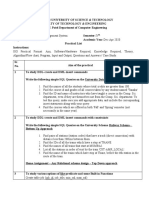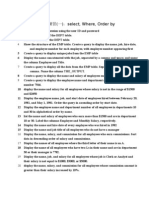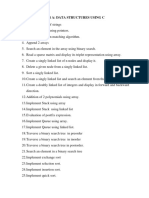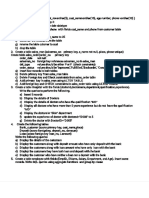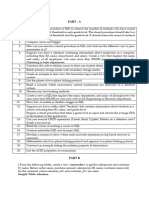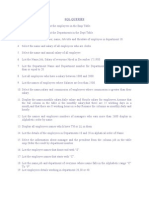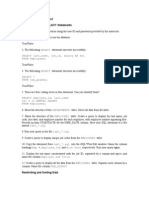0 ratings0% found this document useful (0 votes)
47 views1 SQL Question
1 SQL Question
Uploaded by
Huy Vu QuocThis document outlines the tasks for a database lab assignment. It includes:
1. The schema for tables to model product data including regions, departments, employees, customers, products, and orders.
2. Instructions to connect as a new database user and create a database using a provided script.
3. Tasks to generate an ER diagram and write SQL queries to retrieve and analyze data from the tables. Queries include finding employee details, filtering data, aggregating results, and performing calculations.
Copyright:
© All Rights Reserved
Available Formats
Download as PDF, TXT or read online from Scribd
1 SQL Question
1 SQL Question
Uploaded by
Huy Vu Quoc0 ratings0% found this document useful (0 votes)
47 views4 pagesThis document outlines the tasks for a database lab assignment. It includes:
1. The schema for tables to model product data including regions, departments, employees, customers, products, and orders.
2. Instructions to connect as a new database user and create a database using a provided script.
3. Tasks to generate an ER diagram and write SQL queries to retrieve and analyze data from the tables. Queries include finding employee details, filtering data, aggregating results, and performing calculations.
Original Title
1_SQL_question
Copyright
© © All Rights Reserved
Available Formats
PDF, TXT or read online from Scribd
Share this document
Did you find this document useful?
Is this content inappropriate?
This document outlines the tasks for a database lab assignment. It includes:
1. The schema for tables to model product data including regions, departments, employees, customers, products, and orders.
2. Instructions to connect as a new database user and create a database using a provided script.
3. Tasks to generate an ER diagram and write SQL queries to retrieve and analyze data from the tables. Queries include finding employee details, filtering data, aggregating results, and performing calculations.
Copyright:
© All Rights Reserved
Available Formats
Download as PDF, TXT or read online from Scribd
Download as pdf or txt
0 ratings0% found this document useful (0 votes)
47 views4 pages1 SQL Question
1 SQL Question
Uploaded by
Huy Vu QuocThis document outlines the tasks for a database lab assignment. It includes:
1. The schema for tables to model product data including regions, departments, employees, customers, products, and orders.
2. Instructions to connect as a new database user and create a database using a provided script.
3. Tasks to generate an ER diagram and write SQL queries to retrieve and analyze data from the tables. Queries include finding employee details, filtering data, aggregating results, and performing calculations.
Copyright:
© All Rights Reserved
Available Formats
Download as PDF, TXT or read online from Scribd
Download as pdf or txt
You are on page 1of 4
LAB: WEEK 1
I. Product relational schema:
s_region(id,name)
s_title(title)
s_dept(id,name,region_id)
s_emp(id,last_name,first_name,userid,start_date,comments,manager_id,title,dep
t_id, salary,commission_pct)
s_customer(id,name,phone,address,city,state,country,zip_code,credit_rating,sale
s_rep_id,region_id,comments)
s_product(id,name,short_desc,suggested_whlsl_price,whlsl_units)
s_ord(id,customer_id,date_ordered,date_shipped,sales_rep_id,total,payment_typ
e,order_filled)
s_item(ord_id,item_id,product_id,price,quantity,quantity_shipped)
II. Connect to sys user and create a user:
--Open Sqlplus and connect to sys
>sqlplus / as sysdba
--Create user
Create user c##myuser identified by password;
Grant DBA to c##myuser;
III. Create a Database and generate a ERD diagram
a. Create a DB:
- Connect to c##myuser (use Oracle SQL Developer).
- Run ‘createProductScript.sql’ file to create and add data to the tables.
b. Generate an entity-relationship (ER) diagram using Oracle SQL Developer
Create a diagram for existing database schema or its subset as follows:
1. Click File → Data Modeler → Import → Data Dictionary.
2. Select a DB connection (add one if none).
3. Click Next.
4. Check one or more schema names.
5. Click Next.
6. Check one or more objects to import.
7. Click Next.
8. Click Finish.
The ERD is displayed.
IV. Use SQL Plus or SQL developer to do the following questions:
1. Display the user id for employee 23.
2. Display the first name, last name, and department number of the
employees in departments 10 and 50 in alphabetical order of last name.
Merge the first name and last name together, and title the column
Employees. (Use ‘||’ to merge columns).
3. Display all employees whose last names contain an “s”.
4. Display the user ids and start date of employees hired between May
5,1990 and May 26, 1991. Order the query results by start date
ascending order.
5. Write a query to show the last name and salary of all employees who
are not making between 1000 and 2500 per month.
6. List the last name and salary of employees who earn more than 1350
who are in department 31, 42, or 50. Label the last name column
Employee Name, and label the salary column Monthly Salary.
7. Display the last name and start date of every employee who was hired
in 1991.
8. Display the employee number, last name, and salary increased by 15%
and expressed as a whole number
9. Display the employee last name and title in parentheses for all
employees. The report should look like the output below.
EMPLOYEE
----------------------------------------------------
Biri(Warehouse Manager)
Catchpole(Warehouse Manager)
Chang(Stock Clerk)
Dancs(Stock Clerk)
Dumas(Sales Representative)
10. Display the product name for products that have “ski” in the name.
11. For each employee, calculate the number of months between today and
the date the employee was hired. Order your result by the number of
months employed. Round the number of months up to the closest whole
number. (use the MONTHS_BETWEEN and ROUND function).
12. Display the highest and lowest order totals in the S_ORD. Label the
columns Highest and Lowest, respectively.
13. Display the product name, product number, and quantity ordered of all
items in order number 101. Label the quantity column ORDERED.
14. Display the customer number and the last name of their sales
representative. Order the list by last name.
15. Display the customer number, customer name, and order number of all
customers and their orders. Display the customer number and name,
even if they have not placed an order.
16. Display all employees by last name and employee number along with
their manager’s last name and manager number.
17. Display all customers and the product number and quantities they
ordered for those customers whose order totaled more than 100000.
18. Display the id, full name of all employees with no manager.
19. Alphabetically display all products having a name beginning with Pro.
20. Display all product ids, names and short descriptions (short_desc) for
all descriptions containing the word bicycle.
21. Determine the number of managers without listing them.
22. Display the customer name, phone, and the number of orders for each
customer.
23. Display the employee number, first name, last name, and user name for
all employees with salaries above the average salary.
24. Display the employee number, first name, and last name for all
employees with a salary above the average salary and that work with
any employee with a last name that contains a “t”.
25. Write a query to display the minimum, maximum, and average salary
for each job type ordered alphabetically.
You might also like
- SQL AntipatternsDocument220 pagesSQL Antipatternsyejr92% (25)
- SQL PrepDocument36 pagesSQL Preptulu pradhanNo ratings yet
- DBMS Practical AssignmentDocument2 pagesDBMS Practical Assignmentsatyal prashant0% (1)
- SQL Unit TestDocument4 pagesSQL Unit TestDouglas SimiyuNo ratings yet
- LabAssignment_2_QuestionsDocument2 pagesLabAssignment_2_Questionskimlien250704No ratings yet
- Spring-2024 Database System Assignment # 3: Ofcomputer&Emergingsciencesfaisalabad-ChiniotcampusDocument3 pagesSpring-2024 Database System Assignment # 3: Ofcomputer&Emergingsciencesfaisalabad-ChiniotcampusF223124 Najeeb UllahNo ratings yet
- Lab Practice Sheet- 7 (JOINS)Document3 pagesLab Practice Sheet- 7 (JOINS)ayush.saxena0412No ratings yet
- QueriesDocument10 pagesQueriesRajesh KumarNo ratings yet
- 4sem CE246 DBMS Practical List 2019-20Document6 pages4sem CE246 DBMS Practical List 2019-20Chandresh PadmaniNo ratings yet
- ORACLE SQL - Scenerio Based Part 1 QuestDocument3 pagesORACLE SQL - Scenerio Based Part 1 Questchandramukesh RajaNo ratings yet
- SQL Assingement PDFDocument4 pagesSQL Assingement PDFashushaktimanNo ratings yet
- DBMS AssignmentDocument7 pagesDBMS AssignmentDhariniJeevanandam100% (1)
- Oracle Database AssignmentDocument4 pagesOracle Database Assignmentabhijeet834uNo ratings yet
- DBT Lab Exam FaqsDocument3 pagesDBT Lab Exam FaqsSumit Tembhare0% (1)
- Assignment 3Document2 pagesAssignment 3tanushitcetNo ratings yet
- Database Technologies - Assignment 5Document4 pagesDatabase Technologies - Assignment 5Harshal NardeNo ratings yet
- @ M SSDocument12 pages@ M SSMaryAltheneRacelaPiedadNo ratings yet
- IV Sem DS & RDBMSDocument6 pagesIV Sem DS & RDBMSnihalnih327No ratings yet
- DBMSDocument20 pagesDBMSAbhinav NambiarNo ratings yet
- b24 Oracle PracticeDocument4 pagesb24 Oracle Practiceakash2930No ratings yet
- DBMS Exam ChitsDocument6 pagesDBMS Exam Chitssujit akulwarNo ratings yet
- Dbs Lab AssignmentDocument4 pagesDbs Lab AssignmentJoy Lal ChattarajNo ratings yet
- IV Sem DS & RDBMSDocument6 pagesIV Sem DS & RDBMSShimni ShimNo ratings yet
- SQL HR Case StudyDocument6 pagesSQL HR Case StudykewnrvagjlgavnlaefNo ratings yet
- Class Practical 3 - Chapter 3 QuestionsDocument3 pagesClass Practical 3 - Chapter 3 Questionsnelsonjoshuathomas11No ratings yet
- DBMS Lab SyllabusDocument5 pagesDBMS Lab SyllabusHARICHANDANA DIGAVINTINo ratings yet
- Practice Lessons 1 - SQLDocument4 pagesPractice Lessons 1 - SQLAdityaNo ratings yet
- RDBMS Sample QuestionsDocument4 pagesRDBMS Sample QuestionsJyothikaNo ratings yet
- Oracle Lab RecordDocument3 pagesOracle Lab RecordakurathikotaiahNo ratings yet
- SQL PracticeDocument19 pagesSQL PracticeIslam AshrafNo ratings yet
- sql2 PDFDocument16 pagessql2 PDFheheheNo ratings yet
- Quiz 5Document2 pagesQuiz 5Misbah UllahNo ratings yet
- Assign 3Document1 pageAssign 3Nakul SambheNo ratings yet
- Assignment 2Document8 pagesAssignment 2Mangesh KurambahttiNo ratings yet
- Eee MCT Mech Dbms CIA 2 QBDocument9 pagesEee MCT Mech Dbms CIA 2 QBSukhee SakthivelNo ratings yet
- CECS323 Classic Models Practice SQLDocument5 pagesCECS323 Classic Models Practice SQLVon AleisterNo ratings yet
- Lab 2 21511 CIS183 PDFDocument2 pagesLab 2 21511 CIS183 PDFJenny_Manalansan_839No ratings yet
- DBMS Practical List PDFDocument6 pagesDBMS Practical List PDFlNo ratings yet
- MTA SQL - LAB Assignment 2019 - 20Document3 pagesMTA SQL - LAB Assignment 2019 - 20Sarita MoreNo ratings yet
- LabpspDocument46 pagesLabpspDaraNaveenKumarNo ratings yet
- SQL QueriesDocument6 pagesSQL QueriesMohan Gindi0% (1)
- Lab Performance 03: Solve The FollowingDocument2 pagesLab Performance 03: Solve The Followingpablo chanNo ratings yet
- SQL AssignmentDocument4 pagesSQL AssignmentSairam Varma MNo ratings yet
- IT Cycle SheetDocument8 pagesIT Cycle SheetAnkur AgarwalNo ratings yet
- Consultas SQL: Taller de Base de DatosDocument26 pagesConsultas SQL: Taller de Base de DatosTorres DiegoNo ratings yet
- Cec S 323 Classic Models Practices QLDocument5 pagesCec S 323 Classic Models Practices QLNatalie AoyaNo ratings yet
- Customer ListDocument22 pagesCustomer ListAngelie Conel DizonNo ratings yet
- SQL ExercisesDocument4 pagesSQL ExercisesZephyrTR100% (1)
- Latest Mobile Shoppe - DocDocument17 pagesLatest Mobile Shoppe - DocSunel PendemuNo ratings yet
- RVPL Final ListDocument4 pagesRVPL Final Listhrishi77No ratings yet
- 083 Anshika Jain Ism Practical FileDocument77 pages083 Anshika Jain Ism Practical FileShivamNo ratings yet
- Assignmet_Hr_MySqlDocument6 pagesAssignmet_Hr_MySqlrushikeshkalwane141No ratings yet
- DBMS AssignmentDocument8 pagesDBMS AssignmentMainak ChakrabortyNo ratings yet
- 20MCA28P Practical III RDBMS LABDocument4 pages20MCA28P Practical III RDBMS LABSUBIYA NOORAINNo ratings yet
- Oracle Queries SheetDocument7 pagesOracle Queries SheetChinnam Swamy Chowdary0% (1)
- Principles of Database Systems Lab Cycle PDFDocument2 pagesPrinciples of Database Systems Lab Cycle PDFVamsi KrishnaNo ratings yet
- OCA Practice Day1Document5 pagesOCA Practice Day1Aniisah BadullaNo ratings yet
- Oracle PracticeDocument5 pagesOracle PracticeChandra ChakravarthyNo ratings yet
- SQL Server Functions and tutorials 50 examplesFrom EverandSQL Server Functions and tutorials 50 examplesRating: 1 out of 5 stars1/5 (1)
- Storing and Querying XML Data in SQL ServerDocument46 pagesStoring and Querying XML Data in SQL ServerVlada GrujićNo ratings yet
- Sakthi ResumeDocument2 pagesSakthi ResumetamilvpyNo ratings yet
- CBSE_X_ IT_TERM-1-INTERNAL ASSESSMENT EXAM- QPDocument4 pagesCBSE_X_ IT_TERM-1-INTERNAL ASSESSMENT EXAM- QPtanyyt22No ratings yet
- Oracle For Developers (DBMS SQL) - LabBook2Document30 pagesOracle For Developers (DBMS SQL) - LabBook2Safiya PatelNo ratings yet
- VR Ajp 18 To 20Document8 pagesVR Ajp 18 To 201213 Vaibhav KothareNo ratings yet
- SQL Assignment 1Document4 pagesSQL Assignment 1Prasad Redd50% (2)
- Architecture: Shared-Nothing Mysql Database Management SystemDocument5 pagesArchitecture: Shared-Nothing Mysql Database Management SystemLeandro LealNo ratings yet
- Priya V - PLSQL Dev - ConneqtDocument3 pagesPriya V - PLSQL Dev - ConneqtArchana SinghNo ratings yet
- 1.8.2 Relational Modelling (Answers)Document24 pages1.8.2 Relational Modelling (Answers)Port .D. ACENo ratings yet
- SAP S4HANA ACDOCADocument10 pagesSAP S4HANA ACDOCAKrishna Mohan ReddyNo ratings yet
- Dbms Split Up (Ct3) - Sheet1Document2 pagesDbms Split Up (Ct3) - Sheet1Aradhya M AnilNo ratings yet
- DbmsDocument13 pagesDbms22bce363No ratings yet
- QwertyuiDocument7 pagesQwertyuikmud81.rajNo ratings yet
- Sessions ProdDocument66 pagesSessions ProdpankajNo ratings yet
- Practical Programs With Solution: Computer ScienceDocument22 pagesPractical Programs With Solution: Computer ScienceDhruv JainNo ratings yet
- Java PracticeDocument105 pagesJava PracticeTangudu Tejeswar RaoNo ratings yet
- Elementary IR: Scalable Boolean Text Search: (Compare With R & G 27.1-3)Document22 pagesElementary IR: Scalable Boolean Text Search: (Compare With R & G 27.1-3)raw.junkNo ratings yet
- Relational Algebra: Database Management Systems 3ed, R. Ramakrishnan and J. Gehrke 1Document22 pagesRelational Algebra: Database Management Systems 3ed, R. Ramakrishnan and J. Gehrke 1Md. Shovon Uz ZamanNo ratings yet
- Consistency, Fault Tolerance, and Availability - Clustrix DocumentationDocument4 pagesConsistency, Fault Tolerance, and Availability - Clustrix DocumentationCSKNo ratings yet
- API Notes in HindiDocument11 pagesAPI Notes in HindiPace InfotechNo ratings yet
- Module 4 NosqlDocument8 pagesModule 4 NosqlRaghu NayakNo ratings yet
- Display Session and Kill Session in Oracle 10GDocument2 pagesDisplay Session and Kill Session in Oracle 10GbzounrNo ratings yet
- Star SchemaDocument5 pagesStar Schemarr4wn7e9nkNo ratings yet
- Distributed Database Design MethodologiesDocument14 pagesDistributed Database Design Methodologiessami khanNo ratings yet
- Odi 11gr1certmatrix 11 1 1 9 0 2541436Document18 pagesOdi 11gr1certmatrix 11 1 1 9 0 2541436naveenkumar_naikNo ratings yet
- Shankar Final CSDocument30 pagesShankar Final CSSanjithNo ratings yet
- Database: NormalizationDocument5 pagesDatabase: NormalizationMehwish ShabbirNo ratings yet
- MCQ 2 Merged AdDocument705 pagesMCQ 2 Merged Ad323tejas KayasthaNo ratings yet









